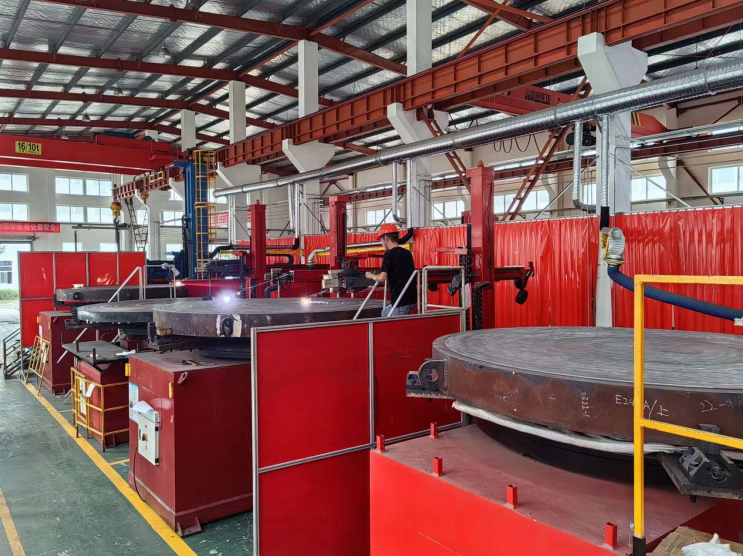Thermal Spraying vs. Spray Welding vs. Overlay Welding: Differences and Connections
In the field of surface engineering and component repair, three widely used technologies—thermal spraying, spray welding, and overlay welding—play a key role in extending service life and enhancing material performance. While their common goal is to improve the surface properties of base materials, their working principles, bonding mechanisms, coating quality, and application scenarios differ significantly. Understanding these differences helps industries select the right solution.

FNS overlay welding solutions for surface engineering
Working Principles of Each Process
1. Thermal Spraying
This process uses a heat source (flame, arc, plasma, or laser) to melt or semi-melt a feed material, which is then atomized and propelled onto a prepared substrate surface. The coating adheres mainly through mechanical bonding, forming a functional layer.
2.Spray Welding
Spray welding is a two-step process that combines aspects of thermal spraying and overlay welding.
- Spraying step: A self-fluxing alloy powder is sprayed onto the component surface, creating a pre-coating layer.
- Remelting step: The layer is then heated by flame or induction to melt and fuse with the base material, forming a dense metallurgical bond.
3. Overlay Welding (Cladding)
Overlay welding is essentially a welding process. Using a high-energy source (arc, plasma arc, laser, or electron beam), both the base material and filler material are melted to form a common molten pool. After cooling, the cladding layer achieves a strong metallurgical bond with the substrate.
Key Differences at a Glance
| Feature | Thermal Spraying | Spray Welding | Overlay Welding |
|---|---|---|---|
| Core Process | Melt and spray material onto surface | Pre-coat alloy powder, then remelt | Directly melt filler onto base |
| Bonding Mechanism | Mainly mechanical, partial metallurgical | Metallurgical via remelting and diffusion | Full metallurgical bonding |
| Dilution Rate | Almost none | Very low (≈1–10%) | Higher (≈5–30%) |
| Heat Input to Base | Low, minimal deformation | Moderate, risk of distortion under remelting | High, higher thermal stress |
| Layer Thickness | 0.1–2 mm | 0.5–5 mm | Typically ≥2 mm |
| Porosity | 1–15% porosity possible | Dense, pore-free | Dense, pore-free |
| Material Range | Metals, ceramics, polymers | Self-fluxing alloys (Ni, Co, Fe-based) | Wide (rods, wires, powders) |
| Typical Use | Wear, corrosion, thermal barriers, repairs | Wear resistance, corrosion protection | Severe wear/corrosion, large part repair |
Connections and Selection Guidelines
Despite their differences, these three technologies are interconnected:
- Shared purpose: All aim to enhance or restore surface performance, not to manufacture entire parts.
- Technology overlap: Spray welding can be seen as a hybrid of thermal spraying (first step) and overlay welding (remelting step).
- Selection basis:
- Choose thermal spraying for low heat input, material diversity, and efficiency.
- Choose spray welding for high bonding strength, dense layers, and applications requiring minimal porosity.
- Choose overlay welding for maximum coating thickness, structural strength, and heavy-duty repair.
In simple terms: thermal spraying is like “painting” the surface, spray welding is like “painting then fusing,” and overlay welding is like “directly welding new material onto old material.”
Applications Across Industries
- Thermal Spraying: Protective coatings in aerospace, gas turbines, and thermal barrier systems.
- Spray Welding: Pump shafts, sealing surfaces, and medium-duty wear-resistant parts.
- Overlay Welding: Heavy machinery repair, mining tools, large-diameter valves, and petrochemical components.
At FNS Pipeline Technology Co., Ltd., we specialize in overlay welding and advanced cladding solutions, offering a wide range of products to meet requirements for wear resistance, corrosion resistance, and high-temperature service.
Frequently Asked Questions (FAQ)
Q1: Which process offers the strongest metallurgical bond?
A1: Overlay welding provides the strongest metallurgical bond, followed by spray welding. Thermal spraying is primarily mechanical bonding.
Q2: Which process has the lowest heat input?
A2: Thermal spraying has the lowest heat input, making it suitable for components sensitive to thermal stress.
Q3: Can spray welding be considered a hybrid process?
A3: Yes. Spray welding combines thermal spraying for deposition and remelting for metallurgical bonding.
Q4: How to choose between spray welding and overlay welding?
A4: For medium-duty wear and corrosion protection with low heat input, choose spray welding. For severe wear and heavy-duty parts, overlay welding is preferred.
Looking to enhance the service life of your critical components?
Contact FNS Pipeline Technology Co., Ltd. today to discuss tailored overlay welding and cladding solutions. Our technical team will provide expert support to help you reduce costs and boost efficiency.


